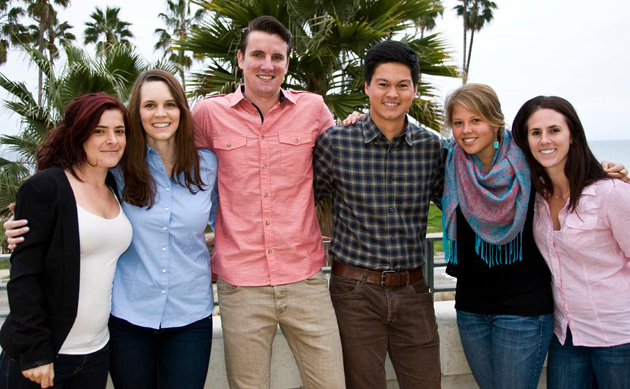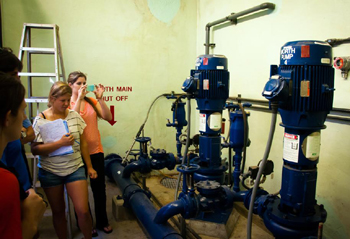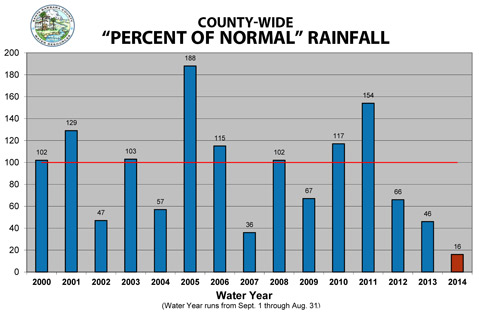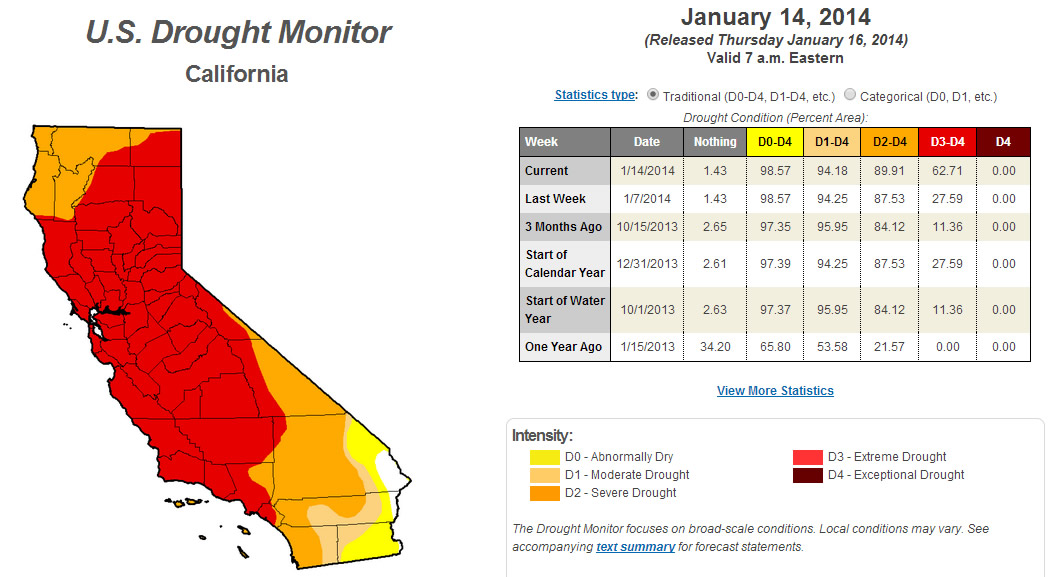California is experiencing one of the driest years on record. In 2013, Santa Barbara County received less than half of its average rainfall, and this year’s rainfall levels are currently 84% below normal. Lake Cachuma, our county’s main water source, is currently only filled to 39% of capacity.
Regions all across the west are also experiencing extreme drought conditions, which prompted Governor Jerry Brown to declare a Drought State of Emergency on January 17, 2014. On January 30th, the National Drought Mitigation Center placed Santa Barbara County under the extreme drought designation noted as D3. Both D3 and D4 (the worst drought category available) conditions indicate severe crop and pasture losses and water shortages.
UCSB has long recognized the state’s vulnerability to drought conditions and the importance of taking proactive measures to reduce water consumption, and it has pursued aggressive water conservation strategies for almost two decades. From 1996/97 to 2010/11, UCSB achieved a 25% potable water reduction through proactive efforts in the following sectors: landscape and irrigation, residential housing and dining commons, industrial applications, and academic / research buildings.
In particular, UCSB’s use of recycled water for irrigation has drastically reduced potable water consumption. The campus utilizes treated water from Goleta Sanitary District and uses it for irrigation, rather than dumping it into the ocean. 90% of the campus landscape is irrigated with recycled water, which saves 19.5 million gallons of potable water annually. UCSB has also seen significant water use savings through efficiency improvements in the use of industrial water and restroom retrofits.
Comparing UCSB’s potable water consumption to our neighbors in Goleta, Santa Barbara, and Montecito helps to illustrate the level of effort the campus has made to reduce potable water consumption over the last few decades. Current potable water consumption compared to our neighbors (2012):
- Students in UCSB Housing: 29 gallons/person/day
- Goleta Water District: 66 gallons/person/day
- City of Santa Barbara: 86 gallons/person/day
- Montecito Water District: 290 gallons/person/day
UCSB not only has the lowest per capita potable water use in the County, but it is continuing its efforts to further reduce water usage. UCSB implemented its first Water Action Plan in 2013. With a Drought State of Emergency being declared for California, UCSB has used this Water Action Plan and identified immediate actions to reduce water consumption on-campus.
The university’s first priority is to reduce potable water use even further. One way to reduce potable water use is to find more venues for the use of non-potable water (a.k.a. recycled water). One potential area in which to expand the use of recycled water would be industrial equipment, such as cooling towers. UCSB is also researching possible methods for recapturing and using water from lab equipment. The campus has also secured a TGIF grant and matching funds from Facilities Management to install faucet aerators and dual flush valves across campus. By targeting the least efficient fixtures, the campus will save millions of gallons of potable water this year.
In addition to structural changes, there are small changes in people’s everyday lives that could really make a difference in conserving water—simply taking shorter showers and turning off the water while you’re brushing your teeth can help save a lot of water. We are hoping that UCSB can be an example for the greater community, and that we can all work together to conserve water. Join UCSB in taking action today for a greener tomorrow.
Editor’s note: Many thanks to Jewel Snavely, Sustainability Coordinator / TGIF grant manager for the University of California, Santa Barbara, for contributing this material. For more on the subject, see the 2013 article, “UCSB Receives National Recognition for Leading the Way in Water Conservation.”







